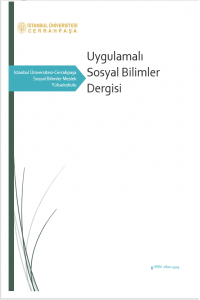EDUCATIONAL SYNERGY AND INSTITUTIONAL HARMONY FOR BETTERMENT: GUIDING NOTICE FOR CURRICULUM LEADERS
ABSTRACTIncreasing the quality of education at schools has always been one of the ambitionseducational leaders desire to approach systematically. Therefore, successfulschools have always been placed under the spotlight; while examining how successfulthey happened to be and what steps were taken towards becoming a successfulschool. This study proposes educational synergy and institutional harmony as thekey to success and draws attention to these concepts as the projection of successfulschools. Having mentioned the significance of creating a synergy and harmony andpronouncing Hall's Three-Dimensional Model of Culture, the problem of mentalityfossilization at various levels is discussed. Then, the concept of mentality change isproposed as a solution to the problem.Key Concepts: IYILESTIRME CALISMALARINDA EĞITIM SINERJISI VEKURUMSAL UYUM: MUFREDAT LIDERLERI ICIN YONLENDIRMECIUYARILAROZETEğitim liderleri icin okullardaki eğitimin niteliğinin arttırılması her zamansistematik yaklasılan bir amac olagelmistir. Bu nedenle basarılı okullarhep mercek altına alınmıslar; bir yandan nasıl basarılı oldukları incelenirken,ote yandan basarılı olma yolunda hangi adımların atıldığı belirlenmeyecalısılmıstır. Bu calısma eğitim sinerjisini ve kurumsal uyumu basarınıniki onemli anahtarı olarak onermekte ve basarılı okulların bir izdusumuolarak bu kavramlara dikkat cekmektedir. Sinerjinin olusturulması veuyumun sağlanması icin atılabilecek adımlar tartısıldıktan ve Hall'in Uc-Boyutlu Kultur Modeli belirtildikten sonra anlayı fosillesmesi kavramtemelliolasısorunları değsik duzlemleri ifade edilmekte ve bu sorunsalacozum olarak anlayı değsimi kavramıileri surulmektedir.Anahtar Kavramlar: Eğitim sinerjisi, kurumsal uyum, anlayıs fosillesmesi,anlayıs değisimi, yapıcı iletisim, faydacı etkilesim, kapsayıcı okul.Educational synergy, institutional harmony, mentality fossilization,mentality change, constructive communication, beneficiary interaction, inclusiveschool.
Anahtar Kelimeler:
Anahtar Kavramlar: Eğitim sinerjisi, kurumsal uyum, anlayış fosilleşmesi, anlayış değişimi, yapıcı iletişim, faydacı etkileşim, kapsayıcı okul
___
- Apple, M., & Beane, J. (Eds.). (2007). Democratic Schools: Lessons in Powerful Education, 2nd ed. Portsmouth, NH: Heinemann.
- Byrnes, H. (1998). Constructing Curricula in Collegiate Foreign Language Departments. In Learning Foreign and Second Languages, 2nd ed. (pp. 262-295). New York: Modern Language Association of America.
- Glatthorn, A., Boschee, F., & Whitehead, B. (2006). Chapter 1: The nature of curriculum. In Curriculum Implementation (pp.3-32). Thousand Oaks, CA:Sage. Development and
- Glickman, C., Gordon, S., & Ross-Gordon, J. (2005). Chapter 19: Curriculum development. In Supervision and Instructional Leadership (pp. 293- 315). Boston: Pearson.
- Gordon, S. (2004). Curriculum development. In Professional Development for School Improvement (pp. 236-261). Boston: Allyn & Bacon.
- Hewitt, T. (2006). Chapter 11: Managing and implementing the curriculum. In Understanding and shaping the curriculum (pp. 287-314). Thousand Oaks, CA:Sage.
- Kavrakoğlu, İ. (1999). Toplumun çıkarı için: Çatışma değil İşbirliği. In Boğaziçi Üniversitesi Mezun- lar Derneği Yayın Organı, summer - pp. 37-40.
- Kugelmass, J. (2004). The Inclusive School: Sustaining Equity and Standards. New York: Teachers College Press.
- Kumaravadivelu, B. (2003). Beyond Methods: Macrostrategies for Language Teaching, Yale University Press, 2003.
- Scheurich, J., & Skrla, L. (2003). Leadership for Equity and Excellence: Creating High- achievement Classrooms, Schools, and Districts. Thousand Oaks, CA: Corwin Press.
- Van Lier, L. (1998). Constraints and Resources in Classroom Talk. Issues of Equality and Symmetry. In Learning Foreign and Second Languages, 2nd ed. (pp. 157-182). New York: Modern Language Association of America.
- Walker, D., & Soltis, J. (1986). Chapter 6: Aims Revisited. In Curriculum and Aims. (pp. 67-83). New York: Teachers College Press.
- Başlangıç: 2007
- Yayıncı: İstanbul Üniversitesi-Cerrahpaşa
Sayıdaki Diğer Makaleler
İŞ ÇEVRİMLERİNİN LİNEER OLMAYAN DİNAMİKLERİ:GOODWİN'İN BÜYÜME ÇEVRİMLERİ VE AMPİRİK BİR UYGULAMA
DOES USING DRAMA IN EFL CLASSES MEET THE NEEDS OF THE LEARNERS?
Müjgan HACOĞLU DENİZ, NUR IŞIK
ABD'DE KONUT FİNANSMAN SİSTEMİ
Cansu ŞARKAYA İÇELLİOĞLU, Cansu İÇELLİOĞLU
PROFIT RATE OF TURKISH MANUFACTURING SECTOR IN A MARXIAN PERSPECTIVE
ALMAN BİRLİK PARTİLERİ VE TÜRKİYE'NİN AB ÜYELİĞİNE İLİŞKİN TUTUMLARI
ENTELEKTÜEL SERMAYENİN ÖNEMİ, SINIFLANDIRILMASI VE ÖLÇME YÖNTEMLERİ: KURAMSAL BİR ÇERÇEVE
ULUSLARARASI MUHASEBE VE TÜRKİYE’DE MUHASEBE HUKUKU
A CASE STUDY OF COMPETITIVENESS IN LATIN AMERICA: SCHUMPETERIAN APPROACH AND NEOSTRUCTURALIST SCHOOL
